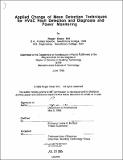Applied change of mean detection techniques for HVAC fault detection and diagnosis and power monitoring
Author(s)
Hill, Roger Owen
DownloadFull printable version (8.822Mb)
Other Contributors
Massachusetts Institute of Technology. Dept. of Architecture.
Advisor
Leslie K. Norford.
Terms of use
Metadata
Show full item recordAbstract
A signal processing technique, the detection of abrupt changes in a time-series signal, is implemented with two different applications related to energy use in buildings. The first application is a signal pre-processor for an advanced electric power monitor, the Nonintrusive Load Monitor (NILM), which is being developed by researchers at the Massachusetts Institute of Technology. A variant form of the generalized likelihood ratio (GLR) change-detection algorithm is determined to be appropriate for detecting power transients which are used by the NILM to uniquely identify the start-up of electric end-uses. An extension of the GLR change-detection technique is used with a second application, fault detection and diagnosis in building heating ventilation and air-conditioning (HVAC) systems. The method developed here analyzes the transient behavior of HVAC sensors to define conditions of correct operation of a computer simulated constant air volume HVAC sub-system. Simulated faults in a water-to-air heat exchanger (coil fouling and a leaky valve) are introduced into the computer model. GLR-based analysis of the transients of the faulted HVAC system is used to uniquely define the faulty state. The fault detection method's sensitivity to input parameters is explored and further avenues for research with this method are suggested.
Description
Thesis (M.S.)--Massachusetts Institute of Technology, Dept. of Architecture, 1995. Includes bibliographical references (leaves [159]-[161]).
Date issued
1995Department
Massachusetts Institute of Technology. Department of ArchitecturePublisher
Massachusetts Institute of Technology
Keywords
Architecture.